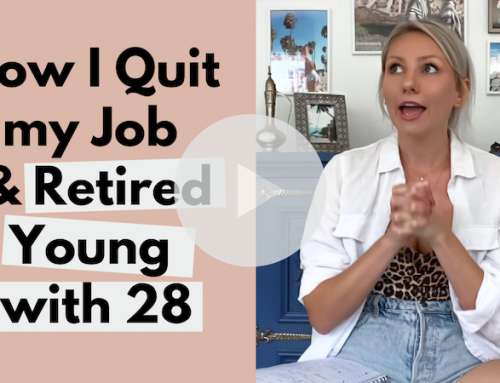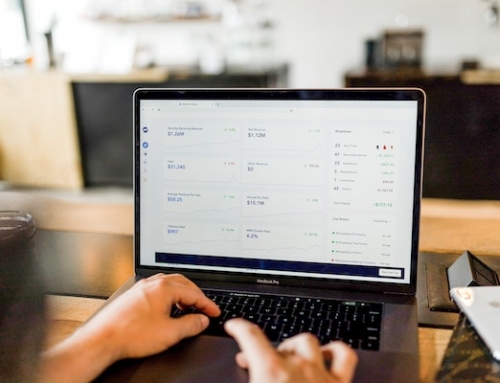You want to learn how to start a blog? I agree, becoming a blogger sounds like a dream job!
You read it everywhere. Once people figure out how to start a blog, they earn a 5-6 figures income while doing what they love. Who wouldn’t want to start a blog and earn money blogging?
So what do you do?
You search for information about how to start a blog successfully. You go through all the blogging advice and How to Start a Blog for Beginners Guides of rich bloggers who made it. Of course you read everything they have to say because you think if they are going to generously put together their success recipes of how to start a successful blog, it would be silly not to try them in your own kitchen.
We did the same … And it let us go absolutely nowhere!
After we created our blog, we spent many months in the desert of absolute stagnation. We published content almost weekly, spent many hours a day on social media, and yet, we got hardly any visitors to our website.
You can imagine, we unknowingly made the most terrible mistakes any new blogger could make.
For example, we didn’t sell any digital products or services via the blog … which is a huge missed opportunity to monetize your blog. Especially when you’re only building up traffic and don’t monetize through ads yet.
Not sure what digital products are, why you should create your own digital product, and how to get started? In this Workbook we take you through the steps to create a profitable digital product and monetize your blog from the beginning.
📌 Save this post to your Blogging Tips board on Pinterest to read it later! 📌


Some of the links in this post are affiliate links. If you use them to make a purchase, we will earn a small commission. There are no additional costs to you, but it helps us keep this blog alive. The products and services we recommend are based on our own opinions. Enjoy!
Who are we to tell you how to start a successful blog?
So why should you keep on reading any tips about how to start a blog from us if we admittedly sucked at blogging in the beginning?
Because something happened that sent us on a blogging roll!
While we used to struggle to get 2,000 monthly sessions in the beginning, we recently passed 200,0000 unique readers to our blog.
A big game changer for us was to not only optimize for Google SEO, but seriously look into Pinterest as a traffic generation gold mine. Today, we get our monthly traffic roughly 50/50 through Pinterest and Google … organically!
If you are a beginner to Pinterest, we recommend you check out our post How to Increase Blog Traffic with Pinterest SEO. That post includes a step-by-step to do list of how to create your Business Pinterest account and set it up to drive traffic to your blog. These tips are based on our learnings of growing our new Pinterest account from 0 to 100k monthly unique viewers in only 2 months.
We finally seem to have cracked what works for us and we want to share our most valuable lessons with you in this post.
Our aim is to be open with you to help you avoid making the same mistakes we made when we started out, and to get you on that same roll.
Let us tell you upfront: We don’t have a magic recipe for you that will make you become a successful blogger in no time. Blogging is work. You will have to put in time and experiment with the strategies we introduce.
But one thing is sure: All the blogging advice and tips we share are based on real experience as recent beginner bloggers. Not on what worked for a rich blogger three years ago.
Is starting a successful blog realistic in 2024?
Blogging is like any other business. The more players move into the arena, the more competitive it gets, and the more challenging it becomes to stand out.
Especially in recent years more people decide that they want to become a blogger and make money blogging. In fact, many social media influencers call themselves bloggers without even owning a website.
Most bloggers fail to create a profitable blog. While this seems mostly bad news, we see it as good news too. How come? Because mostly, bloggers who fail are the ones that give up too early.
Wow, that was a mouthful!
We know, there are plenty of income reports of bloggers that show how they made very good money in less than 3 or 6 months. How discouraging for a beginner blogger that hardly scrapes the first 1000 website visitors after 3 months, isn’t it?!
But honestly, if you reached overnight success, wouldn’t you want to tell the world about it too? So see those extraordinary overnight-success stories for what they truly are … extraordinary than then usual path.
How to start a blog SECRET #1:
The truth is that for most people it takes many months and sometimes even years to get to “overnight success”.
So if you want your blog to succeed, prepare yourself to be patient. Somebody once gave us this advice: Don’t start a blog if you’re not willing to work for one year for free. Now this doesn’t have to be the literal one year (especially if you create and sell a premium digital product or service via your blog). But just manage your expectation. You’re in it for the long game.
Set yourself a timeline and commit to it. If you’re focusing on the right things, we’re confident that success will come eventually. Remember, your strategy is to out-last your competition.
Let us remind you. For the first 8 months we were sitting absolutely dry. Our blog was a ghost town with only some lonely visitors passing by once in a w
hile. Most people would have given up without seeing results in such a long time. We’re glad that we didn’t!
Because that’s when our blog started to pick up. And our number of sessions is increasing by the day.
So, is it still worth it to think about how to start a blog in 2021? Yes, absolutely! That is if you’re willing to put in the hard work and to sit tight patiently in the beginning.
How to pick your niche – a frequent misconception
Do what you’re passionate about and earn money blogging! That’s what the sales pitch of most rich bloggers and their How to Start a Blog for Beginners courses sounds like. The promise is that you can write about stuff you enjoy and make a fortune with it.
Did you notice that most bloggers who claim to be successful offer a blogging course? Travel bloggers, food bloggers, mommy-bloggers, they all tell you at one point or another how you can make money blogging. Again, digital products are according to our opinion the way to go. If you don’t create a course, ebook, or coaching program of your own that you promote on your blog, you miss out. You settle for a 5% commission on an affiliate deal rather than making 100% profit from your own product sales. In this FREE Training, we show you how to do it … see, we’re doing it, too!
This brings us to …
How to start a blog SECRET #2:
Successful bloggers are successful for a reason. They pick a BIG niche that has proven to make money.
What is a successful niche? One with a large audience of people that are willing to spend money.
Are we saying that in order to be successful you can’t write about what you’re passionate about? No, but there are niches that have higher chances for monetary success than others.
Looking at what topics sell on Pinterest (Pinterest is an amazing tool for bloggers as you will learn later in this post), here are the niches with the highest monthly search volumes:
- How to make money
- Personal Finance
- Food & Weight loss
- Travel
- Self-development & Self-care
- Fashion & Beauty
- Home decor & DIY
- Parenting
- Weddings
Define your audience. Who is your ideal reader? What are their characteristics and what problems are they looking to solve? What information are they most interested in?
Then, write for this ideal reader. Instead of trying to fit your content into a certain niche, try to optimize it for your ideal audience. Our tip is to not only create an imaginary ideal reader avatar. Instead think of a person you know either online or offline. This person has a name and a face. You can describe their current situation, their goals, their challenges, and their needs a.k.a. the job for you.
So, whenever you write a new piece of content, think about the reader intent. Ask yourself:
- Who is my ideal reader?
- What do they worry about / struggle with?
- What are their goals and results they aim to achieve?
- How can I add value to them?
- What’s the key question I need to answer for them?
- What’s the answer to that question?
Think about your monetization model. A big part of how you create value for your ideal reader is by suggesting them products and services that you believe will improve their lives. These can be selling third party products (affiliate deals) or create your own (digital) products. You can also combine the two.
Blog post monetization example. Let’s say you are passionate about hiking and you publish a blog post about the best hiking trails on the US West Coast. In the blog, you can refer them to your $15 dollar trail guide (your digital product) that you wrote based on your expert opinion. Additionally, you can link to your favorite hiking shoes on Amazon (affiliate sale). After they have purchased your trail guide, maybe they want to upgrade to your $297 mini-course about how to plan a hiking trip on low-budget. While starting a blog is great on its own, we encourage you to think about your marketable skills and passions and turn them into profitable online products and services. We created this Free Training & Workbook to teach you how.
Now that we addressed the foundations of your blog, let’s move on to how to actually build a successful blog.
The Techy stuff: How to start a blog that is set up for success
After you have decided which ideal audience you want to address with your blog, you can move on to the techy stuff and set up your blog. In short, there are a handful of things you need to arrange:
- Register your domain
- Get hosting
- Set up your WordPress account
- Get a theme
- Pick a newsletter provider
While there are countless tools and resources to pick from when you start a blog, remember this when choosing blogging tools and service providers.
How to start a blog SECRET #3:
To be successful, you need to set up your blog technically for success.
Starting a blog comes almost for free nowadays. That’s why blogging is such a lucrative business. Your initial investment is very low while your returns can be very high. Given you put in the necessary hours and energy of course.
Don’t get blinded by first impressions when choosing providers. Do thorough research.
In the following steps, we will walk you through all technical steps using Bluehost as an example.
We like to recommend Bluehost for your web hosting because their price is hard to beat. You get your monthly subscription for only $3.95 and it comes with a free domain in the first year.
If you decide to go with Bluehost for your web hosting, your domain name will be free for the first year. You will also receive a free SSL certificate, which will be visible via a little lock sign next to your domain name in the browser. This will let website visitors know that your website is secure and their data is processed safely on your website. Other great benefits are unlimited bandwidth and their 24/7 support service.


On their website, they walk you step by step through the entire process from registering your domain name, getting hosting, to setting up your WordPress account. This is great because it takes away the hustle of figuring things out on your own. Especially if it’s your first time starting a blog.
Register your domain name
The first technical step when starting a blog is to get your domain name.
Think of domain name ideas for your blog. Our advice is to pick a domain name that reflects your content and leaves room for expansion at the same time.
Try to make it catchy. You want that readers can remember and return to your website easily.
For example, we picked generationnomads.com because it attracts travel lovers who seek a location independent lifestyle and want to make a living in a freedom-based way. Besides that, the name gives us room to write about additional challenges of our generation beyond digital nomadism, like career change and financial freedom. This wouldn’t be possible if we sticked with twoinflipflops, which was the first domain name we registered!
Once you come up with domain name ideas, you can check here if your domain name idea is still available. Type in your preferred domain name and see whether it’s available to use and how much it costs.


Get hosting
Web hosting service providers make sure that your website can be accessed and viewed online. For this, they provide servers to store your data securely.
The cheapest subscription of Bluehost costs $3.95/month. This basic package comes with a free domain, a free SSL certificate, and unlimited bandwidth. It includes 50 GB SSD storage, which is more than enough in the beginning.
Once your blog’s traffic grows substantially and surpasses the 50 GB, you can upgrade anytime to unlimited SSD storage. This would then be a monthly subscription of $5.95.
The set up processes is straightforward and easy to follow.


Set up your WordPress account
Now comes the fun part! You’re setting up your very own brand new website, so exciting!
Set up your website on wordpress.org. Trust us, this is the open source software you want to use for your blog!
There are other options such as wordpress.com (don’t mix them up with wordpress.org!), Squarespace, or Wix. However they are not as customizable and expendable as wordpress.org.
Being the #1 software for building websites, developers are creating and updating WordPress specific additional features all the time. It has hundreds of design themes to choose from and thousands of plugins available.
When you start out, you might not care about extensions. But if you want to include customized email sign-ups, a web shop, and other gimmicks later, it will be a pain in the butt to do so if you’re not on WordPress from the beginning. You will have to migrate your entire site to WordPress. So be smart and do it right from the beginning!
Creating a WordPress account is simple. Just follow the sign up instructions until you arrive at your dashboard view.
The backbone of your blog is born! You officially have a blog and are a huge step closer on the how to start a blog journey!


1. Step: Set up your headline and tagline


Step 2: Specify your website intensions


You can easily finalize the set-up of your WordPress account in Bluehost


Now you can start creating your blog Pages, blog Posts, set a Menu, link to your socials, and much more.
We know, building a fully functioning blog can seem like an overwhelming task at first. Our recommendation is to pick a blog you love as example and copy components you like. By copy we don’t mean literally copying their content. That would be terrible! For them and for you! We mean that you see them as inspiration and add your own personality and twist to it while following a proven structure that works.
Get an open source or paid blog theme
After your WordPress account is set up, you can move on to picking a design a.k.a. theme. Your theme is the first impression you make on a blog visitor. And you want this impressions to be a good one.
This does not mean that your site needs to look perfect – especially not in the beginning. Don’t be a perfectionist about it. Just make sure that the look of your website doesn’t scare people off. As long as you do that, you’re fine.
Plus, don’t forget that you can polish up your design over time. It’s a work in progress task and comes on your priority list only after creating amazing content that your readers love. Focus on the key (= valuable content) first and foremost!
There are plenty of free themes to choose from. In the beginning, we recommend to go with a free theme. Free WordPress themes are already very good as they come and leave a lot of room for customization. Just make sure it’s responsive to desktop and mobile.


If after some time you realize that your free theme does not support all configurations and functionalities you need, you can decide to purchase a paid theme. You can find a lot of inspiration and previews of available WordPress themes on ThemeForest. In case you’re wondering, we are using the Avada Fusion theme.
Pick a newsletter provider
You probably want to collect email addresses at some point to send out newsletters and promotions. For this, you will need an emailing software. In our opinion, you can’t start building your email list too early, and we’re so glad we focused on it since Day 1!
Imagine, your blog visitors are invisible to you. They come and leave without you being able to interact with them … unless you capture their email!
The benefit of an email list is that your list becomes a valuable asset of ideal-for-you people. You know what they’re interested in. You can tell them about new blog posts, and share product deals to make sales. It’s an audience you can reach again and again!
There are many mailing list services to choose from. We went with GetResponse because of the many options to automate your emails to different target groups.
How to write content as a new blogger
When we started our blog we wanted to write content about how long term travel can help millennials to re-define their career and live a more fulfilled life. We did a competitor analysis and defined how we could differentiate ourselves from other successful bloggers. As a result, we came up with truly unique content ideas that we hardly saw any blog posts about.
We thought we outsmarted everyone else. WRONG!
It took us a long time to understand that there was a reason why there is a lot of content about one topic and hardly any content about another topic.
It’s all about what readers want to read! And even though we still think that some of our less performing content is valuable to our audience, it’s simply not what somebody would type into Google search.
Keep in mind, readers find you through targeted keyword search. Make it easy for them to find you!
How to start a blog SECRET #4:
Stay away from unique content and focus on popular content that has proven to be successful instead.
At least until you have built your brand presence and are generating consistently high traffic to your blog. Once you have a stable number of page views and have a good portion of returning visitors to your site, you can sneak in your own unique content and differentiate yourself that way from competitors.
Now your question is: How do I find the starring content that my audience wants?
We created a *strict routine* we follow every single time before we write a new blog post.
Our strategy consists of the following steps. You can find a detailed explanation of every step and the online research tools we use in our Blogging Secrets Checklist.
- Find your closest competitors on Pinterest and Google
- Research the best performing content of competitors with Busszumo (we use their free trial)
- Find keywords your best competitors use with Moz (paid, but we like it better) or Ubersuggest (free!)
- Do keyword research on Pinterest
- Do keyword research on Google
- Research questions that your audience has with Answerthepublic (free & awesome!)
Start with Google SEO right from the beginning
You have to understand the following. People usually end up on a blog post because they were typing a search query into Google. They are looking to find answers to specific questions.
We’re sorry if we’re the first ones who have to break it to you, but you will thank us later.
How to start a blog SECRET #5:
Nobody cares about you.
Ouch!
This realization is painful, but it is essential for creating a successful blog.
When we started out, our blog posts sounded something like this: “Today we tested the pool in our amazing villa in Thailand. It was raining, but we still went into the water and had a great time.”
Say what? Nobody. Cares. Not even our own families were reading our blog posts!
Let us be clear: You are writing for your ideal audience to help them solve a specific problem. Unless you have an incredibly entertaining or educative story to share that is relevant to the blog post you’re writing, save your personal stuff for your ABOUT US page.
This means you need to get familiar with Google keywords and Google Search Engine Optimization (SEO).
Google needs time to index your blog content. It can easily take a couple of months before you start generating organic traffic from Google SEO. As a reference, it took us about 6 months until Google started showing our first blog posts in their search results.
That doesn’t mean that you shouldn’t focus on Google SEO as a beginner.
Exactly the opposite!
You have to start writing with Google SEO in mind and then wait for Google to pick up your content. Once that happens, you will see a steep increase in your traffic that will stay and grow in the future.
There are a couple of things you need to do to get Google SEO right:
- Find relevant and high search volume keywords research with the Google Keywords Planner
- Install the free Yoast plugin for WordPress for SEO optimization of you blog content
- Write your blog post in a Google keywords optimized way
Increase blog traffic from Day 1 with Pinterest SEO
Ignoring Pinterest for almost one year was one of the biggest blogging mistakes we have ever made!
Pinterest is one of the top social media platforms for bloggers. If you want to be a successful blogger, you need to take Pinterest seriously.
You might not have looked at it that way before but Pinterest is – same as Google – a search engine. The difference is that Pinterest is a visual search engine and that Pinterest has a huge benefit over Google.
As opposed to Google, Pinterest is set up to generate traffic to your blog from Day 1. That’s why it’s so powerful and that’s why you need to learn everything you can about Pinterest marketing. However, it will only work if you master one thing:
How to start a blog SECRET #6:
Pinterest will only help you if you become best friends with Pinterest SEO.
We wrote a detailed blogging for beginners series about Pinterest marketing and Pinterest SEO.
In those two blog posts we help you to set up your Pinterest account for success and write SEO optimized pin descriptions that will start generating traffic to your blog from the beginning.
When starting a new blog: Focus on brand building!
When you’re starting your blog, nobody knows about you yet. That’s why you need to get the word out about your blog and your brand on various mediums and platforms.
How to start a blog SECRET #7:
You need to promote the hell out of your blog.
Think of it roughly as investing 50% on creating content and 50% on promoting your content and your brand.
As you don’t have your own audience yet, your best strategy is to piggyback on other complementary creators’ existing audiences. In other words, find bloggers, creators, and other experts and influencers who address your ideal reader audience and find mutually beneficial collaboration opportunities.
A great strategy is pitching to podcasts. Contact podcasts that talk about similar topics as you and pitch to get invited for interviews. Podcast hosts need new content and you need publicity. It’s a win-win. When you are small, your chances of getting accepted onto podcasts will be higher with small to medium sized podcasts. That’s totally fine though!
Another option is to write guest posts for successful bloggers in your niche. Link back to relevant articles on your blog within the guest post, so that their audience visits your blog as well.
Your main goal in brand building is to gain attention and start building your own community. Try to be creative!
How to start a blog and make money – ways of monetizing
There are different ways to earn money from blogging. The good news is that it’s most commonly the same options that all bloggers use:
- Advertising: Make money from ads
- Affiliate marketing: Earn a commission from selling other people’s products
- Sponsored content: Get paid by companies for product reviews and promotions
- Sale of own Products: Create and sell your own products, e.g. ebooks, online courses, and digital services like coaching
You’re probably wondering which option is the best one for you?
In short, there is no right or wrong. It depends on your situation and goal.
Advertising, affiliate marketing and sponsored posts are most powerful when you have a high quantity of incoming blog traffic. The revenue potential per reader is significantly higher when you sell your own products.
Example calculation. If you sell a $100 affiliate product and earn a 5% commission on each product sale, you need 200 sales to make $1000. Compared to that, if you sell your own digital product for $100, you only need 10 sales to reach the same revenue. Pretty significant, isn’t it?
If you are interested in figuring out what digital product or service you could offer and how to create one that will sell, check out our FREE Training: 5 Steps to create a premium digital service.
Regardless of which business model you choose, note that your business model will determine what you need to focus on when setting up your blog.
How to start a blog SECRET #8:
See your blog as a conversion engine and clearly define which conversion you aim to achieve.
- Ads: Focus on decreasing your bounce rate, while increasing page views and recurring visitors
- Affiliate marketing: Focus on building an affiliate content strategy for your blog content
- Selling products: Focus on building your email list
You can take advantage of all options. However, it’s a good idea to create focus by defining your primary strategy and setting priorities.
In the beginning, you might hardly make any money. Stay patient and trust that results will eventually come in if you keep staying consistent. Your commitment is long term, remember?
Your next steps: What to focus on for how to start a blog
This post about how to start a blog is only the beginning. After you have picked a niche, got your domain, got hosting, and set up your blog on wordpress, the hard work begins!
As we admitted in the beginning of this post, when we started our blog as beginners, we were focusing on the wrong things. We picked the wrong content, wrote in the wrong way, used social media wrongly, the list goes on … After many months of experimenting and learning, we finally found out what worked best for us for growing our blog traffic!
We reached a turning point!
In only 2 months we increased our blog traffic by over 300%. We started promoting our own premium digital products, and started earning $5k+ months.
We stopped thinking as Bloggers and started thinking as Business Owners. The first step was taking a deep look at our marketable skills and turned them into a desirable and profitable online offer that we then sold via our blog. If you want to know the 5 Steps it took us and learn how you can do the same, access our FREE Training here. It comes with a Workbook with guided questions to capture your ideas and create a solid step-by-step plan.









A good read. Brand building should be the main focus. Just writing a blog and leave it that won;t help your business. Promoting on social media platform is the key. Being a blog writer my self, my main focus has always the been my reads and promoting my business by given out information in my each which could be useful to my readers and in turn converting my readers into my customers.
A good read. Brand building should be the main focus. Just writing a blog and leave it that won;t help your business. Promoting on social media platform is the key. Being a blog writer (at content development pros uk) my self, my main focus has always the been my reads and promoting my business by given out information in my each which could be useful to my readers and in turn converting my readers into my customers.
Thank you very much for how to start a successful blog for beginners, it’s difficult for me to get such kind of information most of the time always… I really hope I can work on your tips and it works for me too, I am happy to come across your article.One must check this Waze.co.nz it gives us more info on this topic.
Awesome info on SEO. Your explanation of Pinterest SEO is the best I have read!